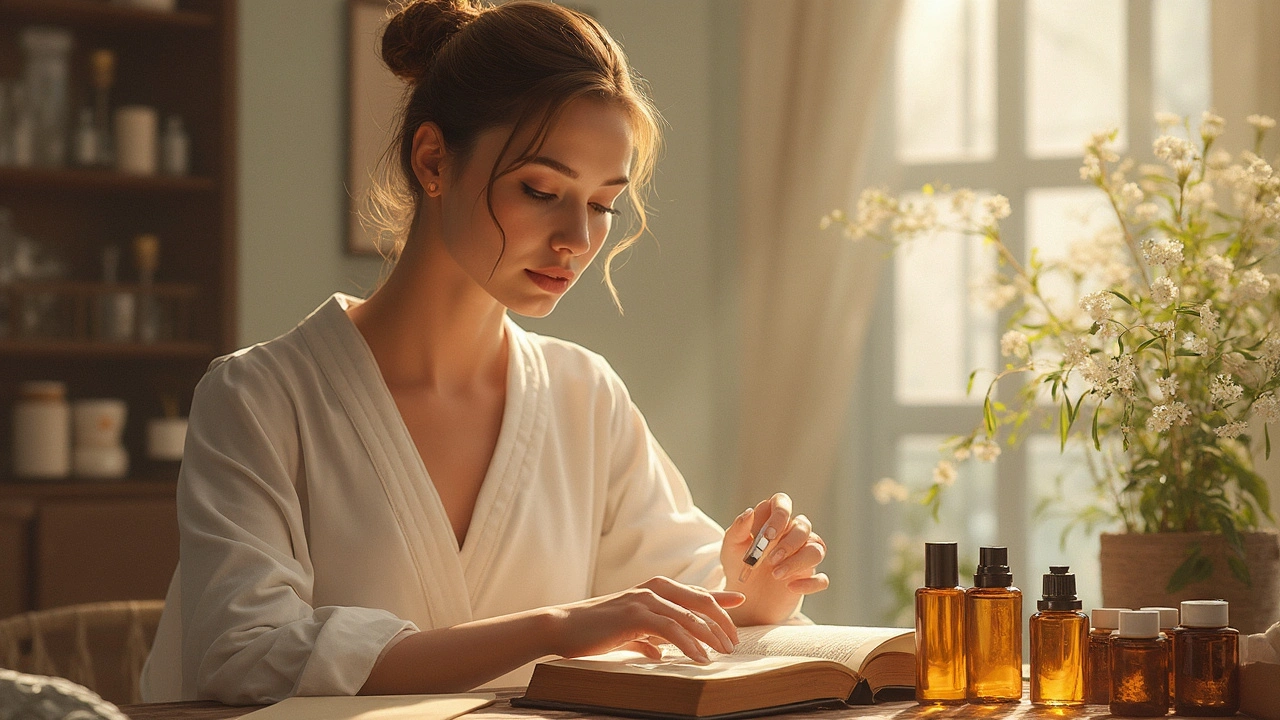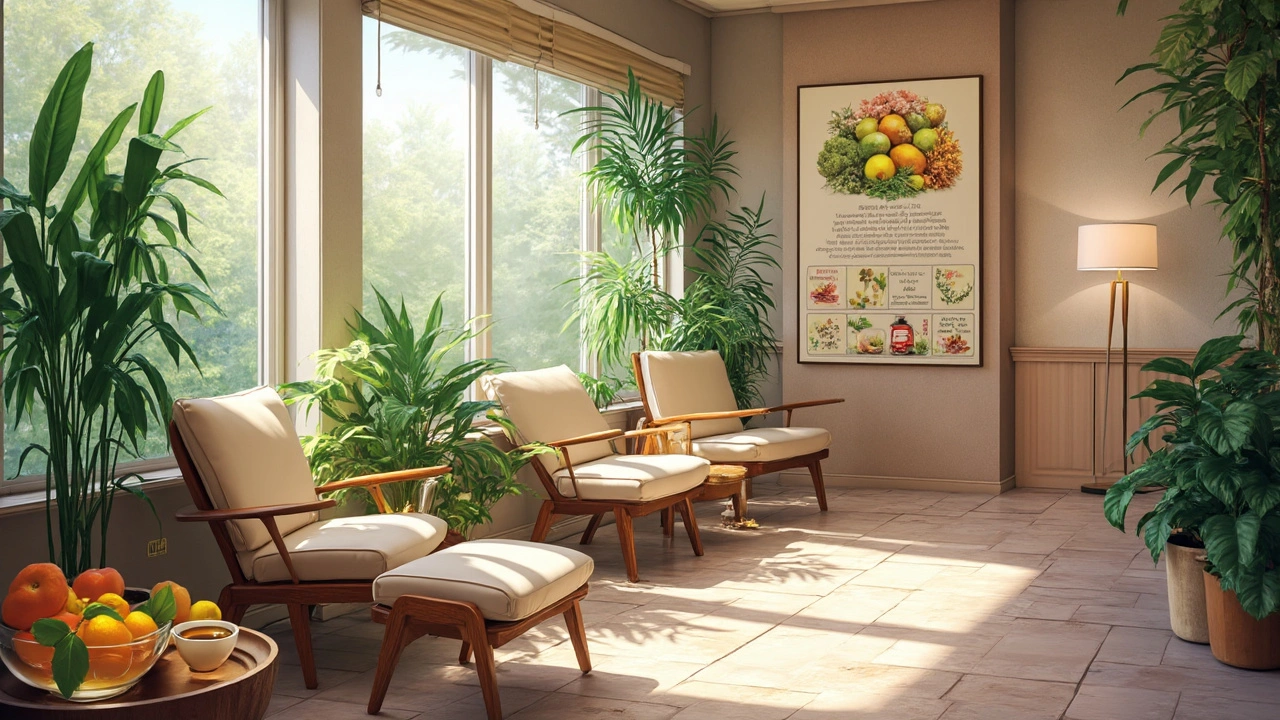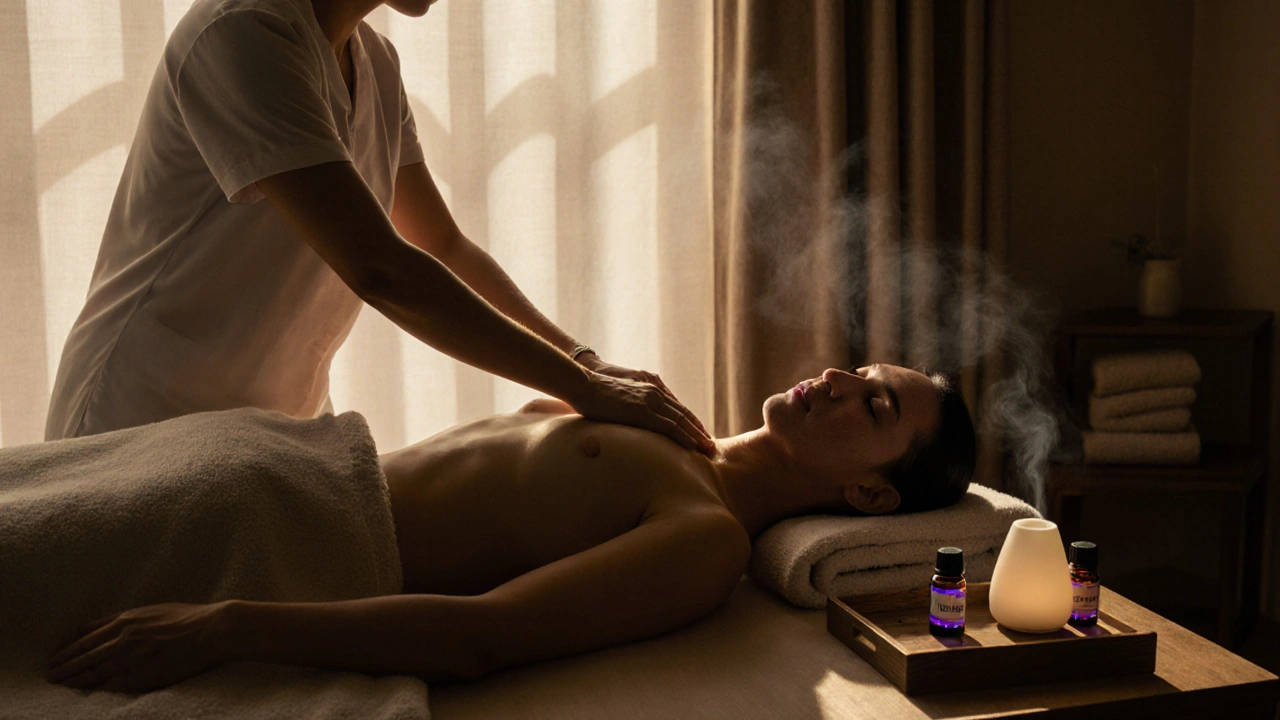Aromatherapy massage combines skilled touch with calming essential oils to reduce stress, improve sleep, and ease muscle tension. Discover how this holistic therapy delivers real wellness benefits backed by science and real user experiences.

- Created by: Archer Caldwell
- Completed on: 14 Jun 2025
- Categories: Aromatherapy Massage
Ever wonder why the smell of lavender makes you instantly chill out? Or how a simple rubdown with the right oil can melt away your stress? If you've ever had an aromatherapy massage, you probably felt the magic, but where did all this start—and how did it become the go-to for anyone needing a break?
Aromatherapy massage mixes two powerful things: human touch and the deep effects of scent. This combo isn’t some modern spa invention. People have been blending oils and giving massages for thousands of years, using them to heal, connect, and restore. From ancient Egypt to your local wellness center, the story of aromatherapy massage is a wild ride through time, tradition, and a whole lot of experimenting with what nature has to offer.
Right now, more folks want natural ways to cope with stress, and aromatherapy massage has come roaring back. Some look for it to ease tension, others for better sleep, while many just want a break from screens and the daily grind. Let’s break down how this practice went from old-school rituals to a staple in modern self-care—as well as what makes it so darn effective.
- Key Points
- Direct Answer
- How Aromatherapy Massage Began
- Why Essential Oils Matter
- Aromatherapy Massage in Everyday Life
Key Points
If you're after the essentials, here are the facts you should know about aromatherapy massage—no fluff, just what counts.
- Aromatherapy massage isn’t new; it has roots in ancient civilizations like Egypt, Greece, and China, dating back over 5,000 years.
- The technique combines massage with essential oils, aiming to relax your mind and body at the same time.
- Essential oils are picked for their specific effects. For example, lavender is linked to stress relief, peppermint perks you up, and eucalyptus helps clear congestion.
- This type of massage is known for decreasing anxiety, improving sleep, and even helping with headaches, according to real patient surveys and several clinical studies published since 2015.
- In recent years, around 30% of regular spa-goers in the US choose aromatherapy massage as their top service, showing its steady rise in popularity.
Here's a quick breakdown of what makes aromatherapy massage stand out compared to classic massage:
| Feature | Aromatherapy Massage | Classic Massage |
|---|---|---|
| Uses Essential Oils | Yes | No |
| Targets Emotional Wellbeing | Yes | Sometimes |
| Custom Scent Options | Always | Rarely |
| Evidence for Stress Relief | Strong | Moderate |
If you're searching for one therapy that checks both the physical and mental relaxation boxes, this is it. You'll find plenty of choices out there, from spa chains to independent therapists, so you can pick what fits your style and needs.
Direct Answer
So what’s the real story behind aromatherapy massage and how did it all begin? This practice goes way back to ancient civilizations like Egypt, China, and India. The Egyptians used aromatic oils and plant extracts in massages as far back as 3,500 BC—not just for pampering, but also for medicine, religious rituals, and even embalming. Meanwhile, early Chinese medical texts described using herbal oils in therapeutic rubdowns, and Ayurveda in India blended massage with fragrant plants for healing body and mind. For centuries, folks believed that good smells could lift mood, ease pain, and improve well-being.
The science has caught up a bit too. Studies now show aromatherapy massage can help lower stress, reduce muscle tension, and improve sleep for many people—even hospitals use it for cancer or surgery patients dealing with anxiety and discomfort. It’s the combo of two things: the physical relaxation from massage, and the emotional or mental boost from inhaling specific essential oils.
Here’s a quick look at how aromatherapy massage is used and what people experience:
- Calms the nervous system and helps with stress
- Relieves muscle aches and stiffness
- Improves circulation
- Boosts mood and mental clarity
- Supports sleep by easing restlessness
The World Health Organization even lists massage and aromatherapy in its list of complementary healthcare approaches used globally, proving how mainstream this blend has become. In the U.S., about 6% of adults say they’ve had an aromatherapy massage in the past year according to a 2023 survey, and that number keeps climbing as more people chase gentle, natural relief.
| Region | Common Essential Oils Used | Main Benefits Reported |
|---|---|---|
| Egypt | Frankincense, myrrh, cedarwood | Relaxation, ritual |
| China | Ginger, peppermint, camphor | Muscle pain, circulation |
| India | Sandalwood, jasmine, rose | Mood boost, stress relief |
Basically, aromatherapy massage is the meeting point of ancient wisdom and modern science—still offering those same calming, healing vibes, no matter where you are or what ails you.

How Aromatherapy Massage Began
If you take a trip back thousands of years, you’ll see how people all over the world used oils and massage to heal and recharge. The ancient Egyptians weren’t just building pyramids—they were mixing up plant oils for massage, beauty, and even embalming. Archaeologists have found recipes written in hieroglyphics that talk about using essential oils like frankincense, myrrh, and cedarwood in everything from medicine to spiritual rituals.
In ancient China, records from over 2,000 years ago mention massage alongside herbal remedies. Chinese healers blended aromatic plants into balms and oils, then used massage to help the body absorb the good stuff. India’s Ayurvedic tradition followed a similar vibe—daily massages with herbal oils were (and still are) part of staying healthy and balanced.
The Greeks got in on the action, too. Hippocrates—yeah, the "Do no harm" guy—recommended scented massages for everything from joint pain to stress. Roman soldiers even got massages with aromatic oils after battles. They believed it boosted recovery and kept them sharp.
Fast forward to the early 1900s in France, and the word "aromatherapy" finally shows up. Chemist René-Maurice Gattefossé accidentally burned his hand and dunked it in lavender oil. The healing shocked him, and he started studying essential oils for medicine and relaxation. That’s where the idea really took off and eventually landed in modern spas and clinics.
Now, aromatherapy massage is everywhere—from fancy resorts to your neighbor’s living room. The main idea hasn’t changed: mixing massage with powerful plant scents is one of the oldest (and simplest) ways to help body and mind chill out and recover.
Why Essential Oils Matter
So, what’s the big deal about essential oils in aromatherapy massage? For starters, these oils aren’t just there to make the room smell nice. They’re packed with compounds that impact both your body and your mind. Lavender, for example, is famous for helping you relax. Peppermint perks you up and can even ease sore muscles. Eucalyptus oil is often used for stuffy noses and tired heads. Basically, each oil brings something different to the table.
Backed by actual science, studies have shown that certain essential oils can reduce anxiety, lower your blood pressure, and even improve your sleep quality. A 2023 study published in the journal ‘Complementary Therapies in Medicine’ found that people who got massaged with lavender oil saw their anxiety levels drop by nearly 30% compared to those who just got a regular massage.
Here’s the thing—when these oils are rubbed into your skin during a massage, some of their active ingredients get absorbed, which can help with inflammation or pain right at the spot that needs care. At the same time, breathing in the scent sends messages straight to your brain and nervous system, firing up what’s called the limbic system. That’s the part in charge of emotions, so it makes sense that the right aroma can totally shift your mood.
Here's a quick look at a few popular oils and their main effects:
| Essential Oil | Main Benefit | Common Use |
|---|---|---|
| Lavender | Calming | Stress Relief, Sleep |
| Peppermint | Invigorating | Headaches, Muscle Relief |
| Eucalyptus | Clearing | Sinus Relief, Fatigue |
| Rosemary | Stimulant | Focus, Memory Boost |
| Tea Tree | Antimicrobial | Skin Care |
Mixing these oils into a aromatherapy massage isn’t just about feeling good. It’s about tailoring the experience for the exact benefit you need. Some massage therapists even let you pick your oils so you can get the vibe that fits your personal needs. If you’re curious, ask your therapist about what oils they use and why—it can make your next session more effective, especially if you know what your body and mind are craving.
- Always let your massage therapist know if you have allergies or sensitive skin.
- Not all oils are safe for everyone—pregnant women and kids should be extra careful.
- Oils should always be diluted with a carrier oil like coconut or almond oil before they touch your skin.
If you’re shopping for oils on your own, look for ones labeled “100% pure essential oil.” Anything with added perfumes or weird chemicals won’t give you the same benefits.

Aromatherapy Massage in Everyday Life
You don't have to book a fancy spa session to enjoy the perks of aromatherapy massage in your daily routine. Plenty of people work it into self-care at home or pop by a local wellness studio for regular stress relief. What’s cool is how this simple combo—touch and scent—can actually shake up how you feel, sleep, and even get stuff done.
Let’s peek at a few ways folks use aromatherapy massage in real life:
- After-work wind-downs: A ten-minute shoulder rub with relaxing oils like lavender or bergamot can ease that "just got home" tension faster than zoning out on the couch.
- Workout recovery: Eucalyptus or peppermint oils mixed into massage oil can help sore muscles bounce back after exercise. Pro athletes in the UK sometimes use this trick post-training.
- Better sleep: Routine foot or back massages with calming oils have been shown in hospital studies to help people fall asleep faster and wake up less at night.
- Natural headache relief: A gentle scalp massage with peppermint oil is a go-to for many instead of popping painkillers for mild tension headaches.
Curious what oils work best for each mood or need? Here’s a quick reference:
| Intended Effect | Popular Essential Oil |
|---|---|
| Relaxation | Lavender, chamomile |
| Energy boost | Citrus oils (orange, lemon) |
| Clear breathing | Eucalyptus, peppermint |
| Better sleep | Bergamot, sandalwood |
| Muscle relief | Black pepper, rosemary |
Now, you might wonder—does this stuff really work? A 2022 study in South Korea looked at office workers stressed out from long hours. The group that got weekly aromatherapy massages for a month scored 35% lower on stress tests compared to those who skipped the massage. That’s a big drop just from oils and touch!
If you’re thinking of making this part of your life, there are a few things to keep in mind. Always dilute essential oils in a carrier oil before putting them on your skin—going straight from bottle to skin can cause irritation. And if you’ve got allergies or skin conditions, start with a patch test on your arm first. Even at home, fifteen minutes of basic aromatherapy massage can make a boring night feel like a mini escape.
Learn the basics of aromatherapy massage: benefits, essential oil selection, beginner routine, safety tips, and how to find certified therapists.
Discover how aromatherapy transforms your body massage experience—boosting relaxation and rejuvenation. Learn essential oil tips, session expectations, pricing, and more.



